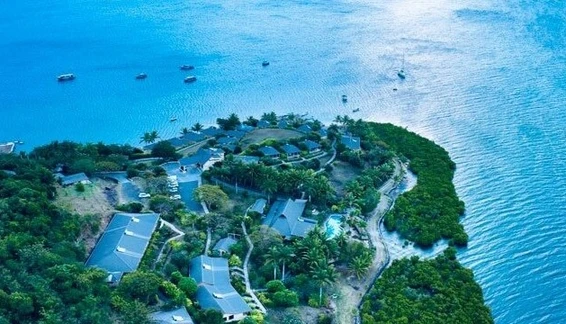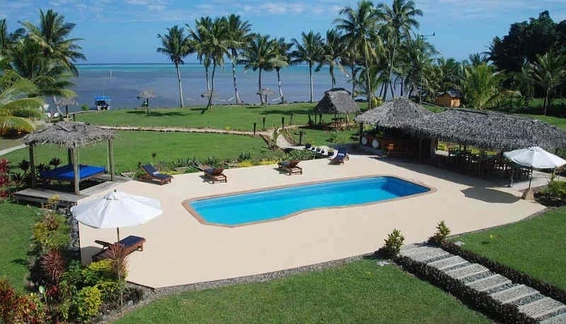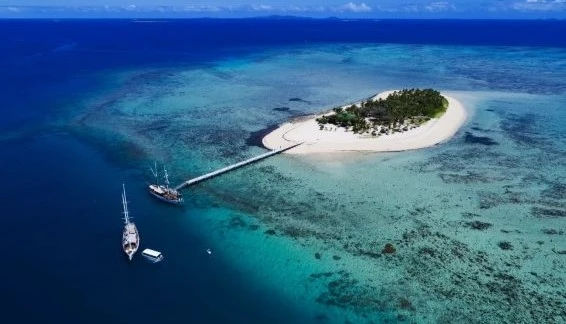Dive Destinations
Liveaboards
Resorts / Day Trips
Scuba Training
...Highlights: shark action, turtles, great macro life/marine diversity, schooling fish & big pelagics...
...Diving environment: healthy reefs, wall dives, drifts, beginner and advanced divers...
Until recently, the main island of Viti Levu was not well known for having the best diving in Fiji. However, Rakiraki in the north of the island and on the coast of Bligh Water is fast becoming recognised for its world-class scuba opportunities that are equal to anywhere else in Fiji. These outstanding sites feature spectacular coral reefs, dramatic pinnacles and huge volumes of fish. There are miles of untouched reefs and new sites are still being mapped and explored by the dive resorts of Rakiraki.
We also highly recommend that any diver's trip to Fiji should include a stay near Pacific Harbour to join the amazing shark feed dive at Shark Reef, where you have a very real chance of once-in-a-lifetime encounters with bull sharks and tiger sharks, species that are rarely seen by divers elsewhere.
Elsewhere, the diving in Viti Levu is characterised by hard coral walls and channels visited by pelagics. Just off the south coast of Viti Levu lie the soft coral bommies and pinnacles of Beqa Lagoon. This is one of the best known scuba diving destinations within Fiji. However, in our opinion, places like the Coral Coast have little in the way of top quality sites and don't really live up to expectations.
The 2 main cities and international airports of Fiji are both located on Viti Levu, making it an ideal choice for divers with limited time to spend on domestic travel.
Discover the underwater world of the awesome Bligh Water. The unspoilt reefs, dramatic drop-offs and abundance of marine life along the east coast of Viti Levu surpass the expectations of even the most demanding diver. You can expect to see gardens of giant sea fans, vibrant soft corals, sponges, invertebrates and masses of colourful reef fish. Finning alongside barracudas, turtles, and numerous species of sharks is a regular occurrence. Manta rays, whales, and dolphins are also occasional visitors to Rakiraki.
> [More details: Rakiraki]Over a decade of protection from fishing has meant that this area, on Fiji's main island, Viti Levu, can be teeming with fish both big and small, but it is the incredible shark feeding experience that make this spot a must see experience for all scuba divers visiting Fiji.
Diving here will find you resting on the sea bed a little distance away from the experienced guides who distribute chunks of fish to any passers-by - and what a sight! 8 different types of sharks frequent this area and cruise by to rip a piece of fish flesh from the outstretched hands of the guides which will send your heart racing! Watch our: Fiji shark diving video.
> [More details: Shark Reef]Once out across the open-sea lagoon, you'll drop into the Vitawatawa Channel that runs along the south coast of Viti Levu. The outside edge of the lagoon forms a wall to the open ocean, and it's here that your dive begins.
Descending down past ledges of pore corals your attention will soon be taken by the common lionfish, sometimes hidden under rock protusions, but often seen parading up and down the wall with their spectacular, barbed pectoral fins raised in display. Blue goldbelly damselfish dance in the bright shallow water, and pairs of speckled angelfish make way for you as you continue your descent.
Once at your deepest level, you just go with the flow, which ever way the current will be running, east or west, along the convoluted wall. Often large swarms of 3-striped fusiliers race past in a silvery blur. Small schools of yellow spotted, striped large-eye bream slowly move away as your approach.
Approaching the lagoon mouth, divers turn inward and the reef wall makes way to a sandy, estuary-like bottom, flanked by rocky walls. If you've never seen them before, now is your chance to see guitar sharks as they often move in and out of the lagoon in search of food. Named for their unmistakable body shape, these rare creatures grow to over 3 metres, are cartilaginous, and belong to ray and shark group of species.
A little further inside the lagoon entrance, several boulder formations form large swim-throughs and, when the tide is running in or out of the lagoon, grey reef sharks gather on the boulder surfaces to hunt for food in the current.
For information on your diving options, and all the travel information you might need to visit Viti Levu and Fiji, see our Viti Levu dive resort section.
Stay in Pacific Harbour on the south coast of Viti Levu for the best daytrip access to the shark diving and Beqa Lagoon. Pacific Harbour is the home of the shark feeding concession at Shark Reef: Pacific Harbour Day Trips. This amazing site is also visited by some resorts on the Coral Coast, such as Waidroka Bay Resort.
The secluded white sandy beaches of Rakiraki on the picturesque north coast of Viti Levu are only 2 hours drive from Nadi International Airport. The best sites in Bligh Water can be reached by boat within 20-30 minutes from the comfort of a north coast dive resort such as Volivoli.
If you are short of time and/or staying in the Nadi area, why not take a day cruise out of Nadi to dive at the picturesque Mamanuca Islands!
 Pacific Harbour Daytrips
Pacific Harbour Daytrips
Customer rating: Excellent!
 VoliVoli Resort
VoliVoli Resort
Customer rating: Excellent!
 Waidroka Bay Resort
Waidroka Bay Resort
Customer rating: Excellent!
 Nadi / Mamanuca Islands Daytrips
Nadi / Mamanuca Islands Daytrips
Customer rating: Be first to rate!
You can visit Viti Levu throughout the year with July, August and September being the peak months for visibility. Given the diving we recommend here, seeing 40 metres is not really necessary as the action takes place just a few metres away from your nose. The warmest water (29°C) can be found in the summertime from November to April.
Off the north coast of Viti Levu, such as at Rakiraki, April to October is considered the very best time of the year. September to November are considered your best chance to spot whales. Off the south coast is Pacific Harbour where the famous shark dives take place. You can spot up to 7 types of shark, most of which are year round. Bull sharks will disappear from November to January to mate, and June to August is your best chance to see tiger sharks.
Viti Levu is a large island (in Fijian terms) and when the rains fall during the summer period, the run-off can reduce visibility at sites near to shore in places like Pacific Harbour and Rakiraki.
Review our map below of the Fiji Islands, showing the location of Viti Levu. Here, you will find information on how to get to Viti Levu.
5 - 35m
5 - 30m
Usually gentle but can be strong
Can be choppy
25 - 29°C
Beginner - advanced
>75, plus access to more in other destinations
1 week, or 2 weeks to dive all areas accessible from here
You guys were fast, knowledgeable and very patient. I would have been more than happy to pay for your service but didn't have to - result! See you next year
